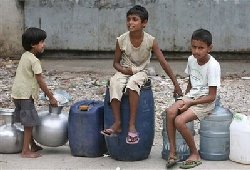Much of Bangladesh's water contains dangerous quantities of arsenic, a toxic compound that cripples human organs and can eventually lead to death.
The country is now scrambling to reverse what the World Health Organization (WHO) calls "the largest mass poisoning in history", but it will not be an easy task.
Arsenic was commonly used as a poison in the 19th century, but in Bangladesh, it occurs naturally in the groundwater, which is pumped up by shallow tube wells.
Millions affected
No one has the exact figures of the number of wells contaminated with arsenic. But according to Ruhul Haq, Bangladesh's health minister, more than 50 per cent of the population is affected by arsenic contamination - that is more than 80 million poisoned people.
The country is now facing a growing epidemic from the effects of long-term exposure to arsenic-contaminated water.
Arsenic poisoning is a slow killer. Apart from skin lesions, its effects are not visible to the naked eye. In recent years, Bangladeshi doctors have recorded a dramatic increase in cancer fatalities.
Dr Salamat Khandker, a consultant with the WHO, believes that the health impact is underestimated because so many cancer cases go unreported and untreated.
"We have seen a 25 per cent increase in patients, but these are only patients with visible symptoms," he says.
"We have not considered the patients who have internal manifestations."
It is these unseen and unknown cases that are the deadliest. The causes of deaths are predominantly cancer of the bladder or lungs, heart disease, and kidney failure.
Many Bangladeshi doctors believe that today's cancer patients are victims of decades of exposure to arsenic-contaminated water.
Costly error
Bangladeshis have not always relied on wells for their water needs. In the 1970s and 1980s, the United Nations Children's Fund (Unicef) and other development agencies funded the Bangladeshi government to dig shallow tube wells across the country.
They did so in order to stamp out the incidence of children dying from water-borne diseases found in ponds, which were traditionally used as a source of drinking water.
The solution seemed simple enough at the time; sink tube wells in every village to provide the population with "clean" drinking water.
But a grave error was made. Despite it being standard practice across the world, no one bothered to check the ground water for arsenic – and Bangladesh has the highest levels of naturally occurring arsenic in ground water in the world.
Not only did those leading this project forget to test the ground water, they did not heed warnings from independent scientists and researchers.
When arsenic poisoning was discovered in the adjoining Indian state of West Bengal in the 1980s, it took years for international aid agencies and the Bangladeshi government to begin tackling the problem.
They only officially recognized the extent of the arsenic poisoning problem in Bangladesh in 1993. Carel de Rooy, the Unicef country representative calls this "a missed opportunity".
But according to Quazi Quamruzzaman of the Dhaka Community Hospital, the government was told as early as in 1985 that Bangladeshis crossing the border into West Bengal were being diagnosed with arsenic poisoning.
Dipankar Chakraborti, the director of Environmental Studies at Jadavpur University in Kolkata, was the first person to warn of the impending arsenic crisis.
Beginning in 1988, as a young researcher, he began testing water in his native West Bengal, and had them tested for arsenic.
Reports came back showing that the water had high levels of the toxic compound.
By the early 90s, Chakraborti had done enough research and testing to realize that the crisis in West Bengal was relatively minor compared to a much bigger calamity across the border in Bangladesh.
Massive survey
Now, decades after the first arsenic alerts were sounded, Bangladeshi authorities and Unicef are finally testing the tube wells in order to gauge the extent of the contamination.
Their task is a daunting one. It will take longer to test all of the tube wells than it took to dig them. Setting up water filter systems or switching to another method of water provision will take much longer.
Another challenge is in convincing people not to drink the poisonous water. Rick Johnston, a water specialist at Unicef, says that it is hard for villagers to stop using the tube wells.
"The tube well water is nice and cool. It's easy. So it's hard to switch to something else. There is a pond here, but the pond is dirty; who wants to drink the pond water?," he says.
"Even if you can build a treatment plant or boil water and make it safe to drink, [people] look at it and they say 'no thanks, we will stick to tube well water'."
Unicef is subsidizing water filters in arsenic affected areas. But even the cheaper ones cost the equivalent of $30 - a small fortune for most Bangladeshis who earn less then $2 a day.
In 2008, the Bangladesh government lobbied the United Nations to make access to clean water a basic human right.
But old habits die hard - tube wells continue to be sunk in Bangladesh.
PHOTO CAPTION
Bangladeshi children sit on empty water containers as they wait for the supply of water in Dhaka, Bangladesh, Tuesday, May 5, 2009.
Source: Aljazeera.net


 Home
Home Discover Islam
Discover Islam Quran Recitations
Quran Recitations Lectures
Lectures
 Fatwa
Fatwa Articles
Articles Fiqh
Fiqh E-Books
E-Books Boys & Girls
Boys & Girls  Ramadan
Ramadan Fatwa Audios
Fatwa Audios Month of Mercy
Month of Mercy Women
Women Eed Al- Fitr
Eed Al- Fitr Food Recipes
Food Recipes Videos
Videos

 Prayer Times
Prayer Times












